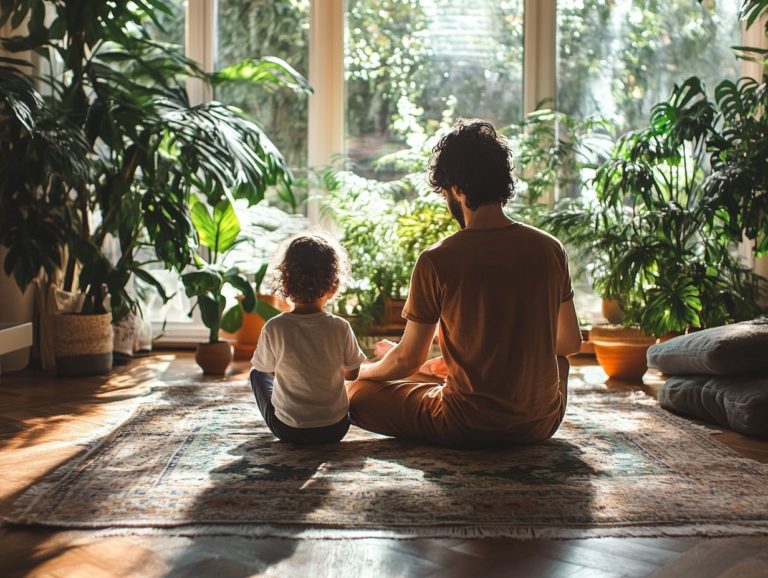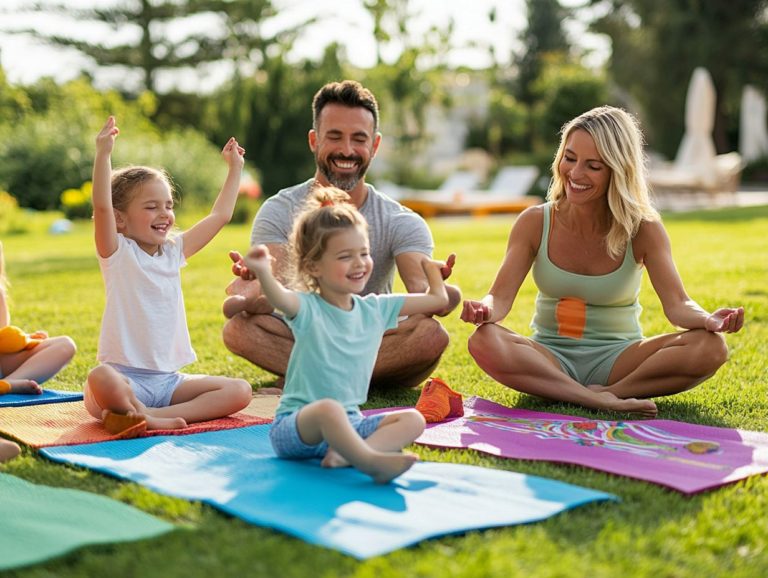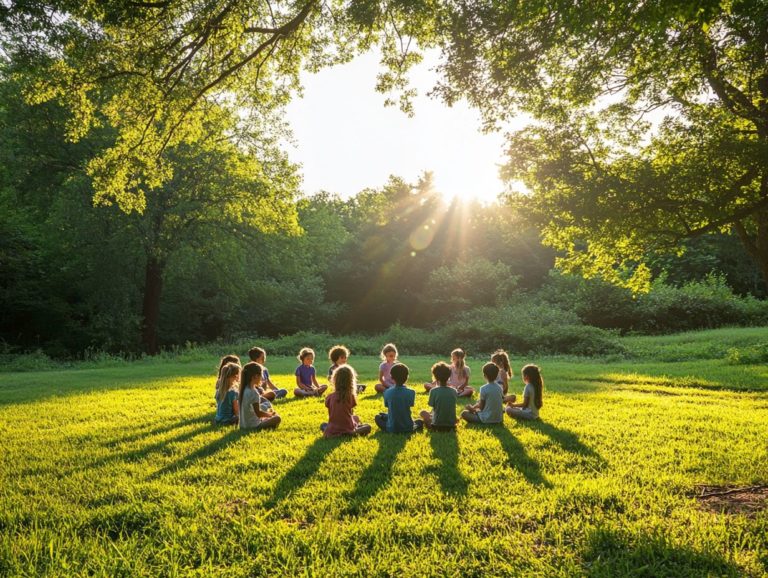5 Ways to Encourage Mindfulness in Children
In today’s fast-paced world, cultivating mindfulness in children is more essential than ever. Discover how you can empower your children today! This article delves into five effective strategies that you, as a parent or educator, can employ to nurture mindfulness in young minds. Mindfulness practices can help children manage anxiety, cultivate focus, and reduce stress.
From leading by example to creating a supportive environment, these tips are designed to foster emotional well-being and resilience. Engaging in children’s mindfulness activities can significantly improve their coping mechanisms and overall well-being.
You’ll also discover the myriad benefits of these mindfulness practices, along with fun and engaging methods to teach mindfulness, such as children mindfulness books and kids meditation. Uncover how you can empower children to thrive both emotionally and mentally through the transformative power of mindfulness.
Contents
- Key Takeaways:
- 1. Lead by Example
- 2. Practice Gratitude
- 3. Incorporate Mindful Activities into Daily Routine
- 4. Encourage Mindful Communication
- 5. Create a Mindful Environment
- What Is Mindfulness and Why Is It Important for Children?
- How Can Parents and Teachers Support Mindfulness in Children?
- What Are the Possible Challenges in Teaching Mindfulness to Children?
- How Can Mindfulness Help Children with Their Emotional and Mental Well-Being?
- Frequently Asked Questions
- Ways to Encourage Mindfulness in Children
- What are 5 ways to encourage mindfulness in children?
- How does mindfulness benefit children?
- What age is appropriate to start teaching mindfulness to children?
- How often should children practice mindfulness?
- Are there any fun ways to encourage mindfulness in children?
- How can I make mindfulness a part of my child’s daily routine?
Key Takeaways:
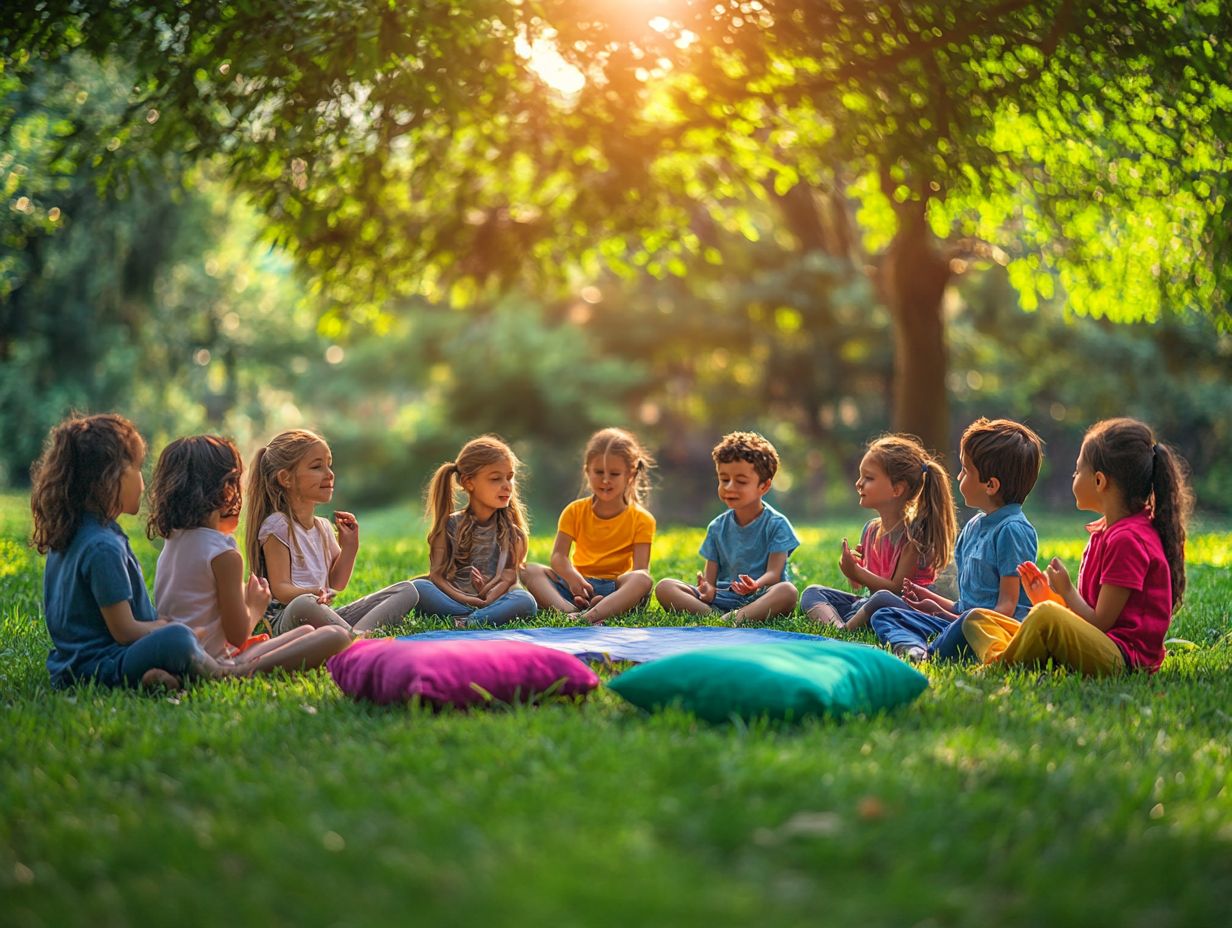
- Lead by example to inspire mindfulness.
- Incorporate gratitude into daily routines.
- Create a supportive and mindful environment.
1. Lead by Example
Leading by example is vital for nurturing mindfulness in children. When you embrace mindfulness, you demonstrate its significance and create an environment for learning.
Mindfulness practices like mindful breathing and breathing exercises enhance children’s emotional awareness. These techniques benefit their academic performance and overall well-being.
Incorporating activities such as focusing on different body parts to relax or mindful walking during family outings can deepen these lessons. This reinforces the notion that being present in the moment holds great value.
By practicing these techniques alongside your children, you not only strengthen your bond but also model healthy coping strategies for navigating life’s challenges. This shared experience cultivates resilience, allowing young ones to express their emotions and understand their reactions more profoundly.
The psychological benefits of embodying these principles go beyond personal growth; they contribute to creating a home atmosphere of openness and support. This environment is essential for nurturing children’s emotional and mental health. You can greatly enhance your child’s well-being through mindful parenting, creating a harmonious and peaceful home.
2. Practice Gratitude
Practicing gratitude is a transformative mindfulness activity that allows you to focus on the positive moments in life. This nurtures emotional awareness and resilience against stress and anxiety.
By weaving gratitude practices into your daily routines, you can inspire children to embrace a positive mindset. Simple yet effective strategies, like keeping a gratitude journal, allow kids to reflect on their day and note down the things they are thankful for. This enhances their mood and shifts their perspective in a meaningful way.
Encouraging them to share kind wishes with family members or friends fosters a supportive environment. This reinforces connections and compassion.
This interplay between gratitude and mindfulness not only aids in developing emotional intelligence but also acts as a vital component in effective stress relief strategies. These practices significantly enhance the overall well-being of children. Kids’ well-being is greatly supported by practices that emphasize kindness and compassion.
Start implementing these strategies today and watch your child thrive!
3. Incorporate Mindful Activities into Daily Routine
Incorporating mindfulness activities into your child’s daily routine can enhance their emotional regulation and stress management skills. This enables them to navigate their feelings more effectively while nurturing their overall well-being.
Mindfulness exercises such as slow breathing and breath awareness can be very beneficial. By integrating mindful eating practices, your kids can learn to savor each bite, fostering a genuine appreciation for food and enhancing their sensory awareness.
Nature walks can serve as a powerful grounding tool, allowing them to connect with their surroundings while promoting physical activity. These activities focus on senses and awareness of surroundings, which are crucial aspects of mindfulness.
Simple breathing exercises can be seamlessly woven into their day, helping them focus, center their thoughts, and calm their minds whenever they feel overwhelmed. These practices instill calm while encouraging children to be present, enhancing their focus and improving thinking skills.
Attention to breath and slow breathing can be particularly effective techniques for children. This enriches their daily experiences and interactions, setting a foundation for a more mindful life.
4. Encourage Mindful Communication
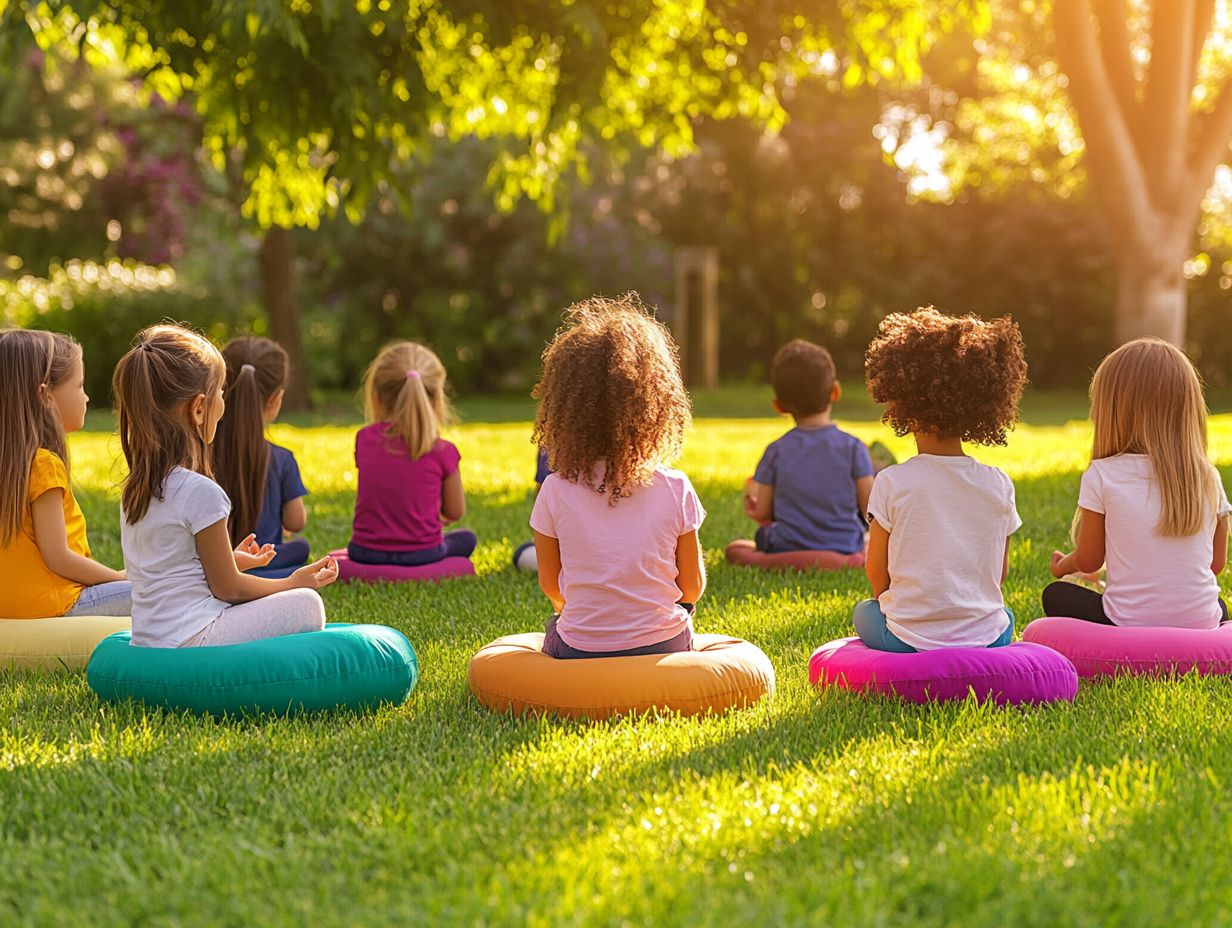
Encouraging mindful communication in children nurtures their emotional awareness and equips them with essential skills such as active listening, empathy, and respectful dialogue skills vital for forging strong relationships. Healthy habits like these significantly boost children’s social interactions.
When they engage in mindful listening, they learn to concentrate fully on the speaker, fostering a connection and understanding that transcends mere words. Techniques like sharing kind wishes where children express positive thoughts or encouragement to others during conversations can greatly enhance their interactions.
Mindfulness techniques such as these significantly boost children’s emotional awareness and empathy. By teaching them to be present and set aside distractions like phones or side conversations, you bolster their ability to engage meaningfully.
These practices not only enrich their immediate social exchanges but also lay a solid foundation for lasting friendships and healthier communication styles as they mature, preparing them for successful interactions in a variety of environments. Mindfulness communication techniques are essential for fostering healthy relationships.
5. Create a Mindful Environment
Creating a mindful environment, whether at home or in the classroom, is crucial for nurturing a culture of mindfulness. This kind of space helps children feel comfortable and calm, allowing them to fully engage in mindfulness practices and develop emotional awareness.
To design such an environment, consider incorporating soothing colors, soft lighting, and natural materials to significantly enhance the atmosphere. Mindfulness tools like cozy cushions for sitting, calming scents such as lavender, or even mindfulness jars filled with glitter can truly captivate their attention and offer sensory experiences that promote relaxation.
By paying attention to their surroundings, children can learn to ground themselves an essential skill for emotional regulation. Establishing quiet zones or reflection areas can encourage them to practice stress management techniques, ultimately fostering resilience and enhancing their overall emotional well-being.
Mindfulness meditation can also be practiced in these quiet areas to further enhance their mental health awareness.
What Is Mindfulness and Why Is It Important for Children?
Mindfulness is a powerful mental practice that invites you to pay attention to the present moment without judgment. This is particularly crucial for children, as it nurtures emotional regulation, enhances focus, and fosters an awareness of the way we think and feel, ultimately paving the way for improved well-being and resilience against stress. Mindfulness includes practices that enhance focus and emotional awareness.
Unlike traditional stress management techniques that often focus on eliminating stressors or distracting oneself, mindfulness encourages a deeper awareness and acceptance of your thoughts and feelings. This practice empowers young individuals to gain a clearer understanding of their emotions, fostering being okay with who you are and equipping them to face life s challenges with grace and composure.
By weaving mindfulness into their daily routines, children can experience remarkable improvements in their emotional development. This leads to heightened academic performance, thanks to sharper focus and enhanced retention of information. The benefits don t stop there; they also contribute to overall mental health, resulting in decreased anxiety and increased resilience that helps them flourish in both school and social settings. Mindfulness can reduce depression and improve attention and well-being in schools.
What Are the Benefits of Teaching Mindfulness to Children?
Teaching mindfulness to children provides a wealth of benefits, including:
- Heightened emotional awareness
- Improved stress reduction
- Enhanced academic performance
It also fosters a greater ability for them to focus and regulate their emotions.
Research shows that children who engage in mindfulness practices are better equipped to manage their emotions, which can lead to stronger relationships with both peers and adults. Experts like Eline Snel highlight the value of simple breathing exercises, such as the ‘Belly Buddies‘ technique, which help children connect their bodies with their feelings, making self-expression more accessible. Mindful parenting techniques can support children in developing these skills.
In a similar vein, Thich Nhat Hanh promotes practices like ‘mindful walking,’ encouraging children to immerse themselves in the present moment, thereby enhancing both focus and creativity. Engaging in these exercises not only nurtures emotional intelligence but also contributes to overall well-being. Mindfulness becomes an invaluable tool in the realms of modern parenting and education. Mindfulness educators like Dr. Mark Bertin and Scott Rogers also emphasize the importance of these practices in children’s development.
What Are Some Fun and Engaging Ways to Teach Mindfulness to Children?
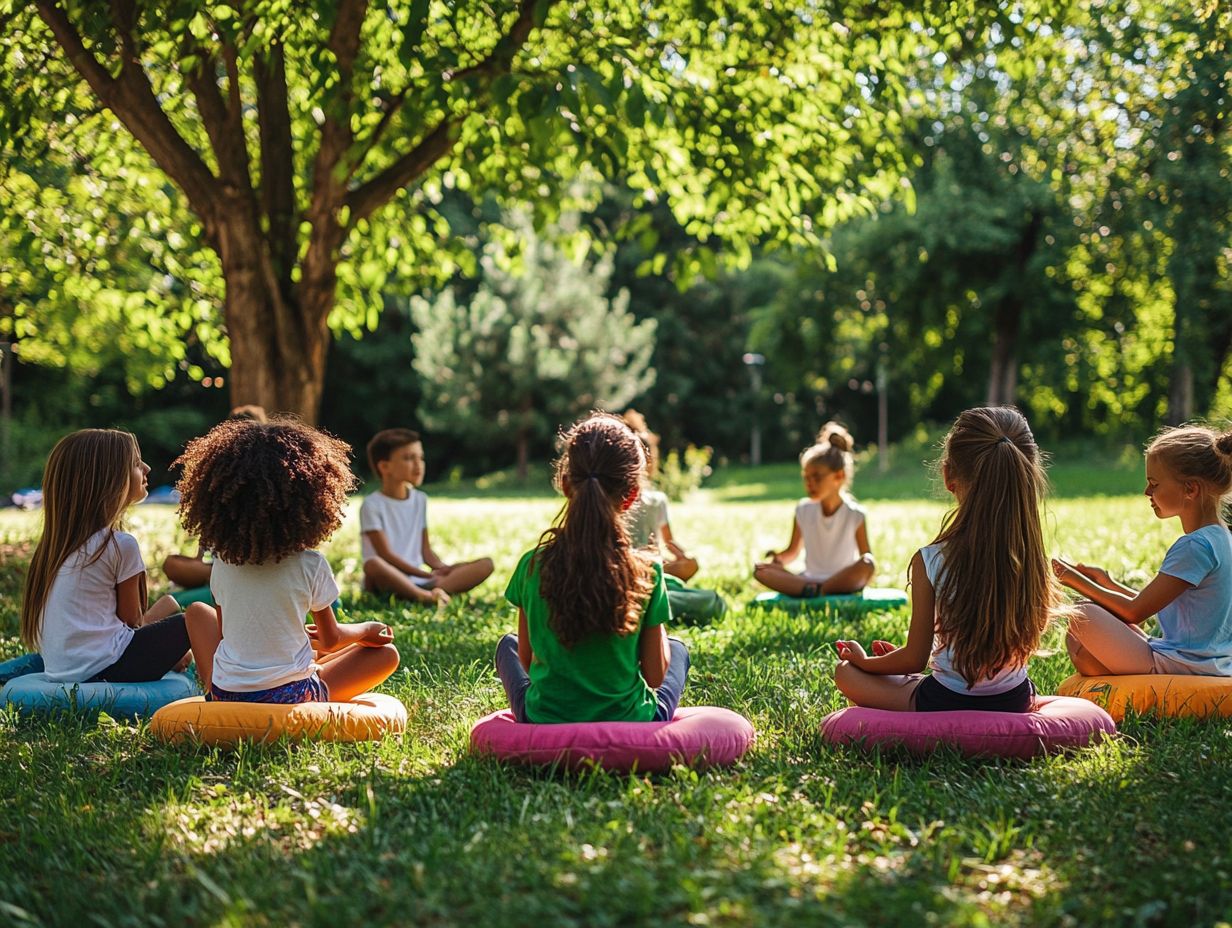
You can explore numerous fun and engaging ways to teach mindfulness to children, including mindfulness games, creative exercises, and simple breathing techniques that transform the practice into an enjoyable and accessible experience. These techniques can be found in various children’s mindfulness books and activities designed specifically for kids.
These activities not only capture their attention but also cultivate a sense of calm and focus, which is essential for their emotional and mental development. For instance, storytelling can help children immerse themselves in narratives that weave in mindfulness themes, allowing them to reflect and connect with their feelings. Creative exercises like kindness meditation and positive moments reflections can further enhance their mindfulness experience.
Nature walks present an excellent opportunity for families to practice family mindfulness together, encouraging kids to observe their surroundings while appreciating the beauty of the world around them. In schools, incorporating guided meditation sessions can promote a peaceful classroom environment, enhancing concentration and learning.
These exciting approaches transform mindfulness into a fun adventure for kids! They create a playful yet enriching atmosphere for cultivating mindfulness, enhancing their emotional well-being and present moment awareness.
Start today and watch your child’s emotional well-being flourish!
How Can Parents and Teachers Support Mindfulness in Children?
You play a crucial role in supporting mindfulness in children by weaving mindfulness techniques into your everyday interactions and educational settings, helping them navigate their emotions and enhance their well-being.
To enrich this journey, consider introducing children’s mindfulness books specifically designed for them. These engaging tools can spark their curiosity and deepen their understanding of the practice.
Create a special quiet space today to help kids unwind and reflect, whether at home or in the classroom. Equip this area with calming objects or resources to foster a sense of peace, encouraging kindness and compassion.
Modeling mindfulness behaviors yourself is essential. When you openly practice being present and attentive, you set a powerful example that reinforces the significance of mindfulness in daily life. Consider learning from experts like Eline Snel, Thich Nhat Hanh, Dr. Mark Bertin, and Scott Rogers.
What Are the Possible Challenges in Teaching Mindfulness to Children?
Teaching mindfulness to children can indeed present a range of challenges. You may find yourself navigating their varying levels of emotional awareness, encountering resistance to new practices, and addressing difficulties in managing stress and attention. These obstacles can impede their ability to fully engage in mindfulness exercises.
As you guide children through mindfulness activities, you might notice some struggling to calm their minds or focus. Some may even view mindfulness as just another task on their never-ending to-do list. This highlights the importance of creating an inviting and supportive environment for them, possibly incorporating the help of a mindfulness educator.
Integrate mindfulness into daily routines instead of treating it as a separate practice to encourage children to embrace these techniques with greater ease. Remember, patience is essential; cultivating the habit of mindfulness in children is a gradual process that requires consistent effort. Over time, this repeated practice will naturally lead to improved emotional regulation, heightened self-awareness, and increased focus. You can also explore 5 ways to practice mindfulness on family outings to enhance these skills in a fun and engaging way.
How Can Mindfulness Help Children with Their Emotional and Mental Well-Being?
Mindfulness can profoundly enhance your child s emotional and mental well-being by equipping them with essential emotional regulation skills, effective stress relief strategies, and a deeper understanding of their own emotions as well as those of others.
Research consistently highlights the transformative impact of mindfulness practices on anxiety and mood disorders, fostering resilience in youth. Experts emphasize that when children engage in mindfulness exercises, such as meditation and breathing techniques, they not only learn to manage immediate stressors but also gain lifelong tools for emotional awareness and thinking skills.
Studies show that children who practice mindfulness exhibit greater focus and improved social skills, paving the way for healthier relationships with their peers. As they navigate their emotions, these young individuals often report diminished feelings of anger and frustration, leading to a more balanced and positive outlook on life.
Frequently Asked Questions
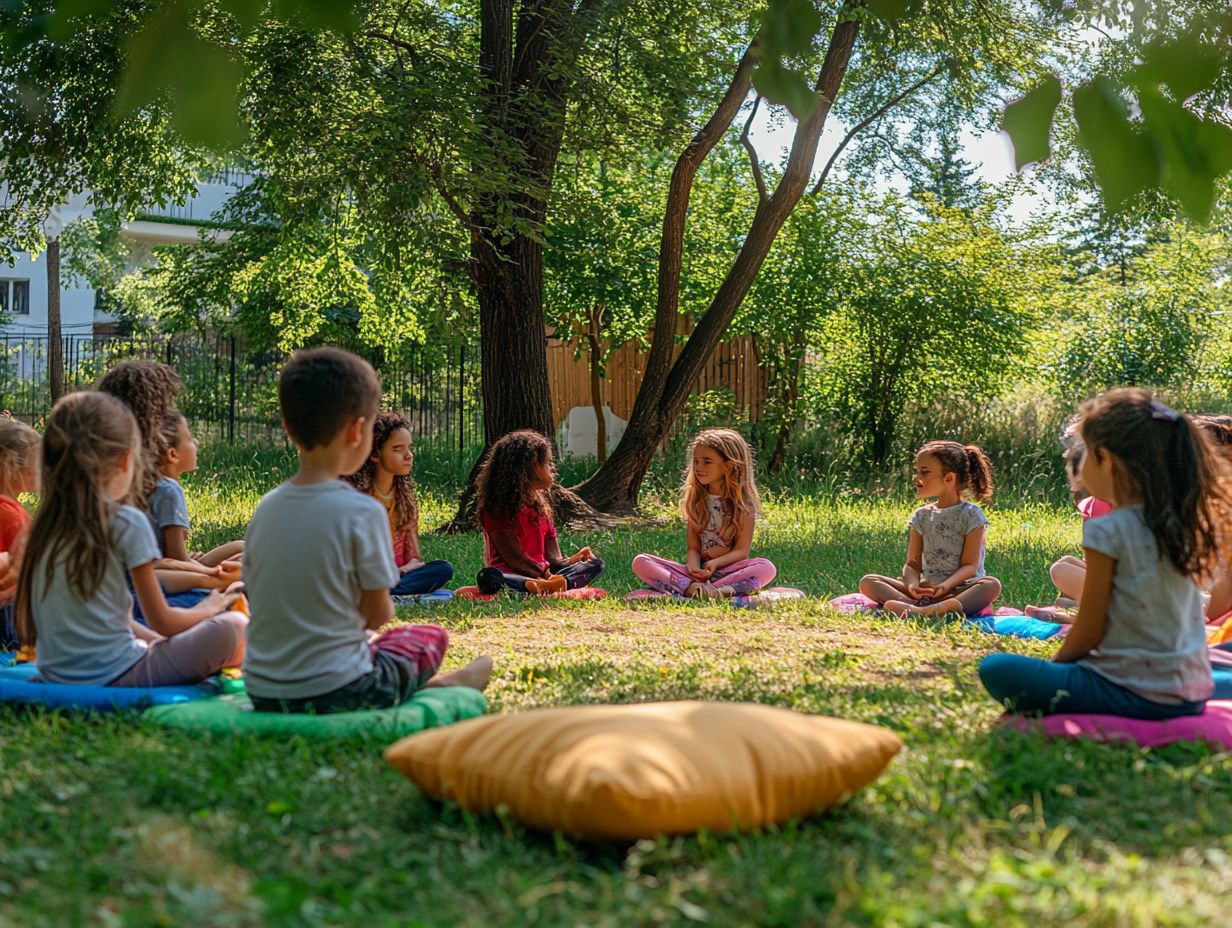
Ways to Encourage Mindfulness in Children
What are 5 ways to encourage mindfulness in children?
1. Engage in mindful activities together: Encourage your child to participate in activities that promote mindfulness, such as yoga, meditation, or breathing exercises. Experts like Scott Rogers suggest these practices.
2. Practice gratitude: Teach your child to be thankful for the little things in life. This fosters present moment awareness.
3. Encourage sensory exploration: Allow your child to explore their surroundings using their five senses. This helps them to be more aware of their surroundings, enhancing children’s emotions.
4. Promote self-reflection: Encourage your child to reflect on their thoughts and feelings. This helps them understand and manage their emotions while reducing anxiety and depression.
5. Lead by example: Children often mimic their parents’ behavior. Make sure to practice mindfulness yourself and set a good example for your child. Implementing mindful moments throughout the day can be particularly effective.
How does mindfulness benefit children?
Mindfulness can improve children’s self-awareness and help them in managing emotions. It also boosts their overall well-being and helps them develop better focus, attention, and problem-solving skills.
What age is appropriate to start teaching mindfulness to children?
Children as young as 3 or 4 years old can begin learning and practicing mindfulness. However, it’s never too late to start, and mindfulness can benefit children of all ages. Introducing children’s books on mindfulness can be a great start.
How often should children practice mindfulness?
Start today! It’s recommended for children to practice mindfulness at least once a day. Incorporating mindful moments throughout the day, such as before meals or bedtime, can also be beneficial. Learning from mindfulness educators like Dr. Mark Bertin can provide valuable insights.
Are there any fun ways to encourage mindfulness in children?
Absolutely! Mindfulness can be a blast! Get creative with drawing or storytelling to make it exciting while fostering a sense of well-being in children.
How can I make mindfulness a part of my child’s daily routine?
You can make mindfulness a part of your child’s daily routine by setting a specific time each day for them to practice, such as before or after school. Incorporate mindfulness into everyday activities, such as during mealtimes or before bed, ensuring they benefit from mindfulness in schools as well.

